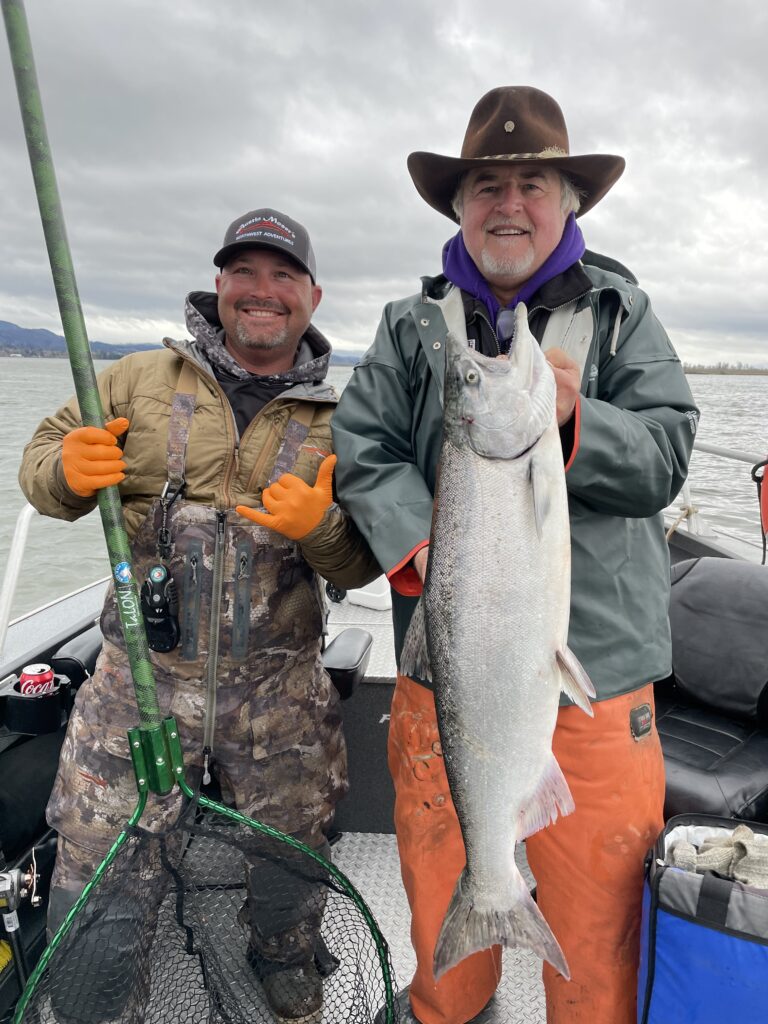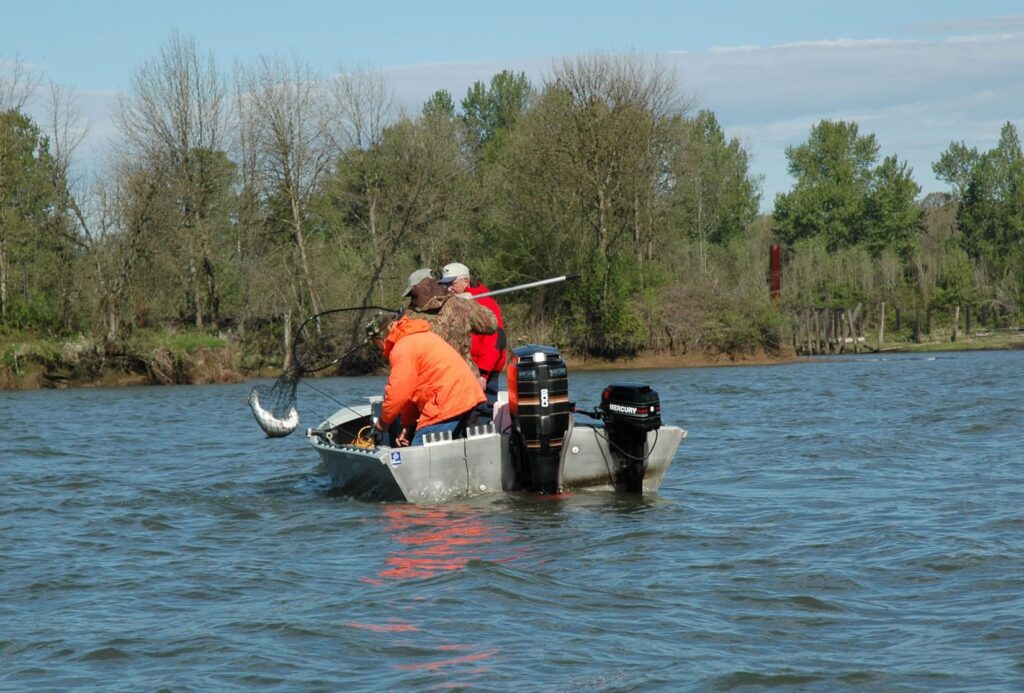Easing into April there’s been a steady buzz anticipating a bumper-crop of coveted spring chinook salmon. It started last December with ODFW’s run forecast that predicted the 2023 springer season would return over 70,000 springers back to the Willamette.
By any measure, that’s a solid run of springers.
It’s early, the catching’s been spotty but for some, steady, if you work at it. Cold weather and water and Columbia choked with smelt have made catching conditions tough but the few that are being harvested are dandies.

I just received a text from legendary salmon catcher Buzz Ramsey. He’s holding a perfect Willamette River specimen. Girthy, with the telltale snow belly and bright face, Buzz’s smile says it all. These April fish are something special…you’ll know it when it hits the grill and fat bubbles up as it cooks. Butter with scales. Buzz knows that fish is going to make a lot of people happy at home.
This time of year the strategy is straightforward. Get a herring spinning like a corkscrew and get it in front of a biter.
There are lots of variations off this theme but one thing most anglers will have in common is using lead to get their herring down.
Straight herring is pretty old school but works. Most prefer some kind of flasher. I like Fish Flash but there are lots of choices. Leader length varies from 3’ to 4’ depending on water clarity and personal taste. Chartreuse is always a good choice for flasher color but again, lots of choices.
The best herring days I’ve had on the Willamette were fishing a Fish Flash that had red prism tape on one side and silver prism tape on the other. I go armed with an arsenal of color choices but day-in and day-out if you have to pick one, chartreuse is a pretty safe bet.
Flashers are an attractor that pull fish to your bait, so fish have to see it for it to work. Under most light and water conditions chartreuse is visible and will get the job done.
I like cut plug blue label herring early in April or I’ll fish whole green label. I like the larger profile. As the water warms in May I’ll scale my baits down to cut plug green label.
I’ve always been a huge fan of scent products. I think they work. More and more I’m seeing some guides and top-flight anglers fishing their herring right out of the package and doing well.
There’s a lot to scents and what to use, when and why. Knowing that fresh baits work well you can kick them into high gear using a herring scent when the water’s below 50 degrees. When it climbs into

the 50’s then anise, herring, sardine, sand shrimp, krill and tuna are all good bets. Into the mid-and-upper 50’s its garlic for me.
I fish 4/0 octopus hooks and thankfully in the Willamette they can have barbs on them.

And, as you’re probably well aware, only hatchery fish can be retained. You’ll know if it’s a hatchery fish if the adipose fin, the small fin just ahead of the tail on the springer’s back has been removed.
We take great care when one of these fish is coming to the boat to determine as quickly as we can if it’s a hatchery fish or not. Our fish stay in the water, in the net until we’re sure it’s of hatchery origin.
The key to catching is attention to detail.
Your herring needs to be spinning. The tighter the spin the better.
4 to 6 ounces of lead is generally plenty under most conditions. You may have to go heavier if the water’s high and the current’s strong.
Keeping your lines with a 45 degree angle is ideal. That angle is your assurance your gear’s working.
If you’re fishing a 360 flasher, that’s a completely different set-up requiring heavier leads and there you’re looking for the rod tip to pulse with the rotation of the flasher. My next blog entry for the second-season springers that kicks in late in May will focus on 360 flasher fishing.
I’m not a fan of dropper leads. Used them for decades but I’ve since adopted VIP Outdoors Line Lock slider and hang my weight off that. I use a 24” Coldwater Strong bumper to my flasher.

The way this rigging works is your main line is tied to a bumper, the bumper is attached to your flasher and your leader and hooks are attached to the back of the flasher. I run my main line through the Line Lock slider and then tie it to the top of my Coldwater Strong bumper. The Line Lock slider has a clip I can attach my cannon ball weight to. The beauty of this set-up is I never have to worry about my weight getting fouled in my flasher. Ever.
The only upside of a dropper lead is if you’re fishing the bottom and need to drop down and reel up a couple cranks to be in the zone. Nearly all our springer fishing in the Willamette from Milwaukie downriver is for suspended fish so we’re either fishing feet on our line counters or pulls off our reels.
A great place to start if you have a line counter on your reel is running your line out 20’. If you’re fishing more than one rod fish one at 20’ and the other at 25’. “Pulls” are just that, a pull of line from the front of your reel to the first guide on your rod…that constitutes a “pull”. 17 pulls is always a good place to start fishing to suspended fish in the Willamette. You can adjust from there, 19 pulls, 20, 25 are all good depths to try.
In the Willamette you can buy a two-rod stamp and two anglers can fish four rods out of the boat. I’ll fish the forward rods (closest to the bow) shallower than the back rods (always) to keep them from getting tangled. Also, always run the back rods out first…this also prevents tangles.
The bottom line key is to keep your rods fishing productively. That means everything’s working and you’re fishing fresh bait at the right depth.
There’s a lot to keep track of for sure. And if you only go out once you’ll likely have a rough time keeping everything straight. It takes time to get comfortable and get dialed in. Springers are, by their nature, tough to catch. The State places the average amount of time to catch one springer at roughly 80 angler hours. Now some will go out and catch several in a single day but, in most cases, those folks have logged years of effort to achieve those results.
The rewards are definitely worth the effort. Spring chinook are arguably the best eating fish on the planet. They’re rich, healthy and uniquely buttery. You don’t need to do much to them when cooking them. Simple salt and pepper is fine. Others will amp it up a bit with cedar planks, basil or lemon. Catch enough of them and you’ll be able to try lots of recipes.
The State says the peak of the run shows around the third week of April and continues into May. Most years that timing is spot-on with excellent fishing AND catching well into May. Over the past decade this fishery has continued into June, and for some, into July, with Chinook being caught at a pretty regular pace. We’ll pick that up in the next blog but for now, April and early May are a great time to get out and get a herring spinning.
Best of luck!